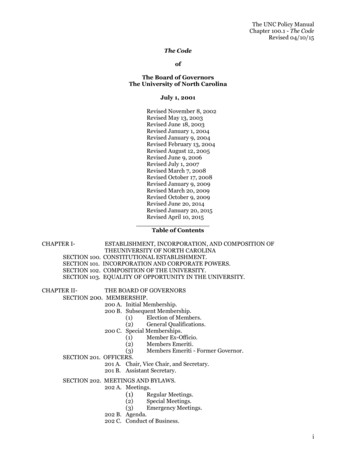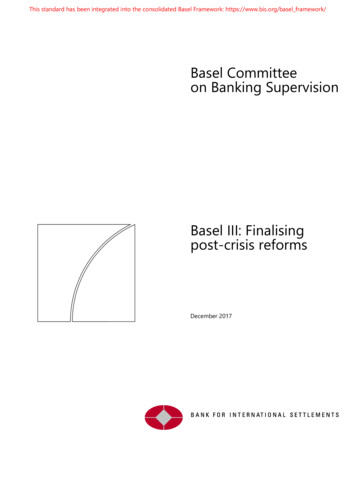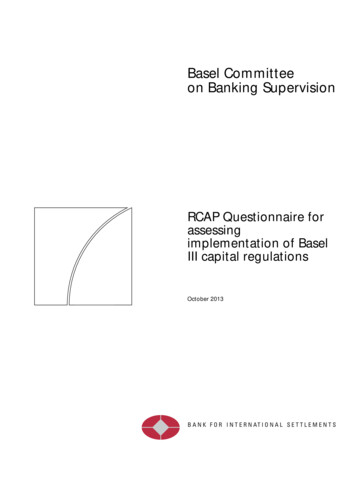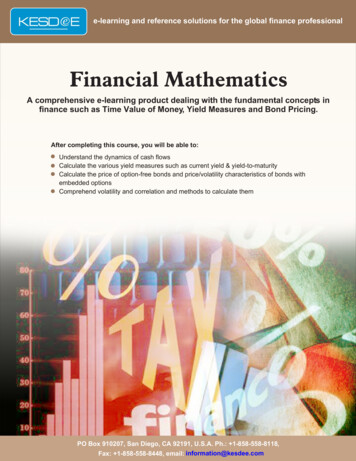
Transcription
www.pwc.comBasel IV: Revised StandardisedApproach for Market RiskOverview of allrequirements of the revisedStandardised Approach forMarket Risk.Increasing risk sensitivity through the“Sensitivities-based Method”
ContentsPreface. 5The revisions to the existing regulatory framework are focusing ondetermination of risk weighted assets. 8The FRTB addresses material weaknesses of the current market riskframework exposed by the financial crisis . 9 and aims to replace the existing regulation and harmonizes thetreatment of market risk across national jurisdictions. 10The FRTB introduces several enhancements to the existing framework. 12FRTB Framework: Sensitivities-based Method. 13The revisions to the standardised approach (Sensitivities-based Method)aim to increase risk sensitivity. 14Sensitivities-based Method Definitions that cover the main concepts . 16FRTB framework uses seven risk classes. 18Linear risks within the Sensitivities-based Method are captured withdelta and vega risk factors. 22Non-linear risks within the Sensitivities-based Method are capturedwith the curvature risk factor. 24The final risk charge for the Sensitivities-based Method is determinedbased on three correlation scenarios. 26Revised Standardised Approach for Market Risk 3
The default risk charge is intended to capture the jump-to-default risk. 28The residual risk add-on is introduced to ensure that the model providessufficient coverage of the market risks. 30FRTB Impacts. 33FRTB will have significant impacts on banks in terms of their operationalcapability, infrastructure, risk measurement, reporting and other areas. 34Typically substantial regulatory changes can be challenging forinstitutions. 36Banks will experience significant increase in capital charges under therevised standardised approach. 37Our Services. 39PwC has developed an MS-Access-based tool that complieswith the final BCBS 352 standards. 40With the tool we are able to do the necessary calculations for thestandardised approach. 414 Revised Standardised Approach for Market Risk
PrefaceRevised Standardised Approach for Market Risk 5
Starting in 2012, the Basel Committee published several consultationpapers on a Fundamental Review of the Trading Book (FRTB) toadapt existing rules for the capitalization of market risk to thelessons learned and shortcomings that became evident during thefinancial crisis. This fundamental review covers all aspects ofminimum capital requirements for market risk such as the tradingbook – banking book boundary, the standardized approach as well asthe use of internal market risk models.Among the proposed changes, none has more profound impacts than the revisedstandardized approach – the so called Sensitivities-based Method. In fact,it is less a standardized method than an internal model approach, developed bythe supervisors. It leads to an enormous increase in data requirements andcomplexity of calculations compared to the current approaches. And it willalso have a significant impact on risk weighted assets, especially with regardto positions subject to optionality or credit spread risks.6 Revised Standardised Approach for Market Risk
The BCBS expects the proposed changes to enter into force in 2019. They willhave to be implemented by standardized approach and internal model banksalike.This brochure will help you gain an overview over the proposed rules toprepare for the tasks ahead.Kind regards,Martin NeisenGlobal Basel IV LeaderOliver J. RosenbergGlobal Basel IV Standardised ApproachWorkstream LeaderRevised Standardised Approach for Market Risk 7
The revisions to the existing regulatory framework arefocusing on determination of risk weighted assetsThe Basel III framework has focused mainly on banks’ own funds requirements.Currently, the Basel Committee on Banking Supervision (BCBS) is in the processof revising the standardised approaches for calculating minimum capitalrequirements. The industry already summarises these revisions under the term“Basel IV”. While the BCBS has not yet officially recognized this term theoutcome is very clear: The revisions will have a fundamental impact on thecalculation of risk weighted assets and capital ratios of all banks regardlessof their size and business model.Fig. 1 Areas of revision by the BCBSCapital requirementsCapitalfloorsInterest raterisk in thebankingbookCredit riskSA forcredit riskSecuriti sationRevisionsto thesecuriti sationframeworkCounter partycredit riskMarketriskOperationalriskCVA riskStep-inriskSA counter- Fundamental Revisions to Review of Step-in riskparty creditreview ofoperational the CVA riskthe tradingriskriskframeworkbook(BCBS 306,BCBS 362) (BCBS 368) (BCBS 347) (BCBS 374) (BCBS 279) (BCBS 352) (BCBS 355) (BCBS 325) (BCBS 349)8 Revised Standardised Approach for Market Risk
The FRTB addresses material weaknesses of the current marketrisk framework exposed by the financial crisis Fig. 2 The fundamental review of the trading book (FRTB): An Overview“The financial crisis exposed material weaknesses in the overall design of the framework forcapitalising trading activities.” (Basel Committee on Banking Supervision, October 2013)Material weaknesses of current approaches require fundamental review1Trading book – bankingbook boundaryTreatment of credit riskin the trading bookWeaknesses of VaRapproachHedging anddiversificationLiquidity of tradingbook positionsTransparency andcomparability of RWA B anking book/trading book boundary to be moreobjective Additional tools for supervision2 N ew standardised approach increases risk sensitivityof RWA calculation Marked increase of complexity3 I nternal models approach using Expected Shortfall (ES)instead of Value-at-Risk (VaR) Changes to model approval process Floor based on standardised methodRevised Standardised Approach for Market Risk 9
and aims to replace the existing regulation and harmonizesthe treatment of market risk across national jurisdictionsDuring the last crisis it turned out that the regulatory capital for market riskwas not adequate enough to cover these risks. Therefore the Basel Committee onBanking Supervision has created with the fundamental review of the tradingbook (FRTB) a new framework to replace the old market risk regulation definedunder “Basel II.5”. The intention is “to improve trading book capital requirementsand to promote consistent implementation of the rules so that they producecomparable levels of capital across jurisdictions”.Fig. 3 Key objectives of the FRTBThe proposals reflect BCBS’s key objectives o develop an effective trading book/banking book boundary condition,T to achieve a regulatory framework that captures and capitalises all market risks in the trading book, to improve risk measurement techniques and to achieve comparable levels of capital across internal risk models and the standardised approach.10 Revised Standardised Approach for Market Risk
The history of the trading book regime1996 Basel IFirst methodology laid out by the BCBS to set outcapital requirements for market risks. The amendmentto the Basel Capital Accord included a standardisedapproach and an internal models approach.2009 Basel 2.5First attempt by the BCBS to address the trading bookissues revealed by the global financial crisis. Revisionsto the Basel II market risk framework.2012–2015Two more consultative papers and fourquantitative impact studies.2004 Basel IIThe amendment was further revised in 2005.The paper changed the trading book regime.2012 FRTBThe BCBS issued the fundamental review of thetrading book (FRTB) consultation paper.2016 Revised standardsIn January 2016 the Basel Committee on BankingSupervision (BCBS) published revised standardsfor minimum capital requirements for market risk.2019BCBS’s deadline for local regulationin January 2019End of 2019Deadline for final implementation.Revised Standardised Approach for Market Risk 11
The FRTB introduces several enhancements to the existingframeworkFig. 4 Overview of the enhancements to the existing market risk frameworkRegulatory boundarybetween trading andbanking book N ew defined list of instruments presumed to be included in the trading book or bankingbook. Deviation requires explicit approval from supervisor. Strict limits on the movement of instruments between the books after initial designation.Should a re-designation be approved a capital benefit will not be allowed.From VaR toES T he new risk measure for market risk according to FRTB is the Expected Shortfall (ES). ES is a coherent risk measure, whereas Value-at-Risk (VaR) is not due to the missingsub-additivity feature. Banks must calibrate the ES to periods of significant market stress. This new metric will help to capture the tail risk and so maintain adequate capital duringperiods of significant market stress.Revisedstandardisedapproach S ignificant changes with introduction of Sensitivities-based methodology. The revised standardised approach will act as a floor to the internal models approach.Inclusion ofmarket illiquidity V arying liquidity horizons included in the internal models approach. Replaces the static 10 day liquidity horizon currently assumed in the VaR framework.Revised approachto approval forinternal models S upervisors will review the use of internal models at desk level. More rigorous model approval process using both qualitative and quantitative criteria.12 Revised Standardised Approach for Market Risk
FRTB FrameworkSensitivities-basedMethodRevised Standardised Approach for Market Risk 13
Delta riskVega riskLinear riskCurvature riskNon-linear riskDefault riskchargeResidual riskadd-onThe revisions to the standardised approach (Sensitivities-basedMethod) aim to increase risk sensitivityThe standardised approach mimimum capital requirement is the sum ofthree components: Sensitivities-based Method and default risk charge providethe main risk factors which are supported by residual risk add-on to sufficientlycover market risks.14 Revised Standardised Approach for Market Risk
Fig. 5 Overview of the revised standardised approachStandardised approach1. Sensitivities-based MethodDelta riskVega riskOptions onlyLinear riskDelta: A risk measure based on sensitivities ofa bank‘s trading book positions to regulatorydelta risk factors.Vega: A risk measure that is also based onsensitivities to regulatory vega risk factorsto be used as inputs to a similar aggregationformula as for delta risks.2. Default risk charge3. Residual riskadd-onCurvature riskNon-linear riskA risk measurewhich captures theincremental risk notcaptured by the deltarisk of price changes inthe value of an option.A risk measure thatcaptures the jump-todefault risk in threeindependent capitalcharge computations.A risk measure tocapture residualrisk, i.e. risk whichis not covered by thecomponents 1. or 2. Calculation of three risk charge figures based on three different scenarios on the specified values for the correlationparameter. The bank must determine each delta and vega sensitivity based upon regulatory pre-defined shifts for thecorresponding risk factors. Two stress scenarios per risk factor have to be calculated and the worst scenario loss is aggregated in order todetermine curvature risk.Revised Standardised Approach for Market Risk 15
Delta riskVega riskLinear riskCurvature riskNon-linear riskDefault riskchargeResidual riskadd-onSensitivities-based MethodDefinitions that cover the main conceptsThe main concepts of the Sensitivities-based Method are given by the supervisor.Especially the relevant risk classes differ in parts from the risk classes used inthe current approach.16 Revised Standardised Approach for Market Risk
Fig. 6 Overview of the definitions that cover the main conceptsDefinition of seven risk classes for the Sensitivities-based Method:RiskclassGIRREquityCommodityCSR (non-SEC)CSR (SEC)CSR (CTP)FXRiskfactor V ariables (e.g. a given vertex of a given interest rate curve or an equity price) within a pricing functiondecomposed from trading book instruments Risk factors are mapped to a risk classRiskposition Main input that enters the risk charge computation Delta and vega risks: sensitivity to a risk factor Curvature risk: worst loss of two stress scenariosBucketSet of risk positions which are grouped together by common characteristicsRiskcharge Amount of capital that a bank should hold as a consequence of the risks it takes Computed as an aggregation of risk positions first at the bucket level, and then across buckets within arisk class defined for the Sensitivities-based MethodRevised Standardised Approach for Market Risk 17
Delta riskVega riskLinear riskCurvature riskNon-linear riskDefault riskchargeResidual riskadd-onFRTB framework uses seven risk classes (1/2)GIRR, Equity, Commodity & FXFig. 7 O verview of risk classes and corresponding risk buckets, risk weightsand correlations (1/2)Risk bucketsGIRR(General interest rate risk)Each bucket represents an individual currencyexposure to GIRREquity B uckets are depending on market capitalisation,economy (emerging or advanced) and sector Total of 11 buckets (e.g. consumer goods andtelecommunication)CommodityEleven buckets are defined for commodity (e.g. energy,freight, metals, grains & oilseed, livestock and otheragriculturals)Foreign Exchange (FX)No specific FX buckets18 Revised Standardised Approach for Market Risk
Risk weightsCorrelations R isk weights (RW) depending on vertices rangingfrom 0.25 years to 30 years Risk weights are ranging from 1.5% to 2.4%Correlations between two sensitivities are dependingon equality of buckets, vertices and curves D ifferentiation between risk weights to equity spotprice and equity repo rate Risk weights for equity spot price ranges from55% to 70%Correlations between two sensitivities for the samebucket (but related to different equity issuer names)are depending on market cap and economy and areranging between 7.5% and 25% T he risk weights depend on the commodity buckets(which group individual commodities by commoncharacteristics) Risk weights range from 20% to 80%Correlations between two sensitivities (same bucket)are defined by a multiplication of factors related tocommodity type, vertices and contract grade / deliverylocationA unique relative risk weight equal to 30% applies toall the FX sensitivities or risk exposuresA uniform correlation parameter equal to 60% appliesto FX sensitivity or risk exposure pairsRevised Standardised Approach for Market Risk 19
Delta riskVega riskLinear riskCurvature riskNon-linear riskDefault riskchargeResidual riskadd-onFRTB framework uses seven risk classes (2/2)Credit spread risk (CSR)Fig. 8 O verview of risk classes and corresponding risk buckets,risk weights and correlations (2/2)Risk bucketsCSR non-securitisation16 buckets defined based on credit quality and sectorCSR correlation tradingportfolio (CTP)The same bucket structure as for CSR nonsecuritisation appliesCSR non-correlationtrading portfolios (n-CTP)25 buckets defined based on credit quality and sector20 Revised Standardised Approach for Market Risk
Risk weightsCorrelations R isk weights are the same for all vertices within eachbucket Risk weights range from 0.5% to 12% C orrelations between sensitivities within the samebucket are depending on names and vertices of thesensitivities, and related curves Separate rules for “other sector” bucket R isk weights are the same for all vertices within eachbucket Risk weights range from 2% to 16%The risk correlations are derived the same way as forCSR non-securitisation, but correlations based oncurves differ slightlyRisk weights range from 0.8% to 3.5% C orrelations between sensitivities within the samebucket and securitisation tranche are depending onnames and vertices of the sensitivities, and relatedcurves Separate rules for “other sector” bucketRevised Standardised Approach for Market Risk 21
Delta riskVega riskLinear riskCurvature riskNon-linear riskDefault riskchargeResidual riskadd-onLinear risks within the Sensitivities-based Method are capturedwith delta and vega risk factorsThe computational procedure for linear risks can be divided into thefive calculation steps shown below. Delta and vega risk measures are basedon sensitivities of bank’s trading book positions to regulatory predetermineddelta and vega factors, respectively. These measures are used to calculate theminimum capital requirements for Sensitivities-based method.22 Revised Standardised Approach for Market Risk
Fig. 9 Overview of the computational procedure for the linear risk chargeSupervisory formulaeDetailsCalculation ofthe risk factor’ssensitivitiese.g. for GIRR:3Calculation ofweighted sensitivitiesper bucket via givensupervisory RWThe corresponding RW are defined by the supervisor4Aggregation ofweighted sensitivitiesper bucketThe risk position for bucket b, Kb, must bedetermined by aggregating the weightedsensitivities to risk factors within the same bucketusing the corresponding prescribed correlation ρ kl5Aggregation ofcapital charge on riskclass level T he risk charge is determined from risk positionsaggregated between the buckets within each riskclass Sb and Sc are the sums of the weightedsensitivities in the corresponding bucketsRiskfactor2BucketAssignment ofpositions to riskclasses, bucketsand risk factorsRiskclass1All positionsCalculation D elta and vega risks are computed using the sameaggregation formulae on all relevant risk factors Separate calculation (no diversification benefitrecognised) T he sensitivities are defined by the supervisor Sensitivities for each risk class are expressed inthe reporting currency of the bankRevised Standardised Approach for Market Risk 23
Delta riskVega riskLinear riskCurvature riskNon-linear riskDefault riskchargeResidual riskadd-onNon-linear risks within the Sensitivities-based Method arecaptured with the curvature risk factorThe computational procedure approach for non-linear risks can be dividedinto three calculation steps that are shown below. The curvature risk measurerepresents the incremental risk not captured by the delta risk of price changesin the value of an option.24 Revised Standardised Approach for Market Risk
Fig. 10 Overview of the computational procedure for the non-linear risk chargeCalculationSupervisory formulaeDetails1Finding a netcurvature riskcharge CVRkacrossinstruments toeach curvaturerisk factor k O nly for risk positions with explicit orembedded options T wo stress scenarios are to becomputed per risk factor (an upwardshock and a downward shock) T he worse potential loss of thetwo scenarios, after deduction of thedelta risk positions, is the outcome ofthe first scenario2Aggregation ofcurvature riskexposure withineach bucket usingthe correspondingprescribedcorrelation ρ kl (CVRk, CVRl) is a function that takesthevalue 0 if CVRk and CVRl both havenegative signs I n all other cases, (CVRk, CVRl)takes the value of 13Aggregation ofcurvature riskpositions acrossbuckets withineach risk class (Sb, Sc) is a function that takes thevalue 0 if Sb and Sc both have negativesigns. In all other cases, (Sb, Sc) takesthe value of 1.Revised Standardised Approach for Market Risk 25
Delta riskVega riskLinear riskCurvature riskNon-linear riskDefault riskchargeResidual riskadd-onThe final risk charge for the Sensitivities-based Method isdetermined based on three correlation scenariosIn order to address the risk that correlations increase or decrease inperiods of financial stress, three risk charge figures are to be calculated foreach risk class. This is done by using multipliers for correlation parameters ρ(correlation between risk factors within a bucket) and γ (correlation acrossbucket within a risk class).Capital charges must be calculated for each correlation scenario.The final capital charge is the largest of these scenario-related capital charges.26 Revised Standardised Approach for Market Risk
Fig. 11 Overview of the correlation scenariosThe correlation scenariosLow correlationsMedium correlationsHigh 5Sensitivities-based Method capital chargeRevised Standardised Approach for Market Risk 27
Delta riskVega riskLinear riskCurvature riskNon-linear riskDefault riskchargeResidual riskadd-onThe default risk charge is intended to capture the jump-todefault riskThe default risk charge is independent from the other capital charges for CSRnon-securitisations and securitisations in the standardised approach.28 Revised Standardised Approach for Market Risk
Fig. 12 Overview of the computational procedure for the default risk chargeCalculation1Calculationof gross JTDpositions2Calculationof net JTDpositions34Supervisory formulaeThe jump-to-default (JTD) risk is computedfor each instrument separately. JTD risk is afunction of notional amount (or face value)and market value of the instruments andprescribed Loss given Default (LGD) figures.e.g. Non-securitisation: long bond positionand short equity position to the same obligorHedge benefitrecognitionBucket allocationand calculationof weighted netJTD positionsand defaultcapital charge(DRC)DetailsThe net JTD risk positions are calculated byusing specified offsetting rules.In order to recognize hedging relationshipbetween long and short positions within abucket, a hedge benefit ratio is computedand applied to discount the hedge benefits.e.g. for non-securitization and securitizationnon-correlation trading portfolio (NCTP) J TD positions are allocated to bucketsand weighted. For non-securitization riskweights are prescribed and for securitizationrisk weights are to be computed applyingthe banking book regime. F or non-securitization and securitizationNCTP the overall capital charge is thesimple sum of the bucket level risks. For thecorrelation trading portfolio capital chargeis the sum of positive bucket level risks andhalf of the negative bucket level risks.Revised Standardised Approach for Market Risk 29
Delta riskVega riskLinear riskCurvature riskNon-linear riskDefault riskchargeResidual riskadd-onThe residual risk add-on is introduced to ensure that the modelprovides sufficient coverage of the market risksAs not all market risks can be captured with the standardised approach withoutnecessitating an unduly complex regime, a residual risk add-on wasintroduced to the framework. It is to be calculated for all instrumentsbearing residual risk separately and in addition to any other capitalrequirements within the standardised approach. The scope of instruments thatare subject to the residual risk add-on must not have an impact in terms ofincreasing or decreasing the scope of risk factors subject to the otherstandardised approach components.30 Revised Standardised Approach for Market Risk
Fig. 13 Overview of the residual risk chargeCalculationResidual risk add-onDetails T he residual risk add-on is the simple sum of gross notional amounts of the instrumentsbearing residual risks RW 1.0% for instruments with an exotic underlying (e.g. longevity risk, weather ornatural disasters) RW 0.1% for instruments bearing other residual risksCriteria for instruments bearing other residual risksI nstruments subject to vega or curvature risk capitalcharges in the trading book and with pay-offs thatcannot be written or perfectly replicated as a finite linearcombination of vanilla options with a single underlyingequity price, commodity price, exchange rate, bond price,CDS price or interest rate swapInstruments which fall under the definition of thecorrelation trading portfolio (CTP), except for thoseinstruments which are recognised in the market riskframework as eligible hedges of risks within the CTPA non-exhaustive list of other residual risks types andinstruments that may fall within the criteriaThe following risk types by itself will not cause theinstrument to be subject to the residual risk add-onGap risk, correlation risk and behavioural riskSmile risk (a special form of the implicit volatility riskof options) or dividend risk arising from a derivativeinstrumentRevised Standardised Approach for Market Risk 31
32 Revised Standardised Approach for Market Risk
FRTB ImpactsRevised Standardised Approach for Market Risk 33
FRTB will have significant impacts on banks in terms of theiroperational capability, infrastructure, risk measurement,reporting and other areasThe institutions are faced with a variety of adjustments and changes in themethodology of calculating the capital charge for market risk. Results of thequantitative impact studies published by the Basel Committee (BCBS 346)predict a simple mean increase of 41% and a weighted averageincrease of 74% in total market risk capital requirements. Still,some of this impact can be mitigated by portfolio re-optimization.34 Revised Standardised Approach for Market Risk
Fig. 14 Impact of the FRTBCapital optimisation A sset classes and trading deskscontributing mainly to the capital chargeshould be identified and their portfoliosanalysed T his may lead to the identification of dataissues increasing regulatory capital A dapting the asset allocation canminimize the capital chargeDesk level review Desk level review will likely increase the complexity of internalmodels, which need to be tailored to each desk Banks need to consider if they need to restructure their desks toreduce complexity related to models and the capital calculationDesk levelreviewCapitaloptimisationRegulatory reporting Business specifications must be inplace defining the aggregation & finalreporting processRegulatory Optionality features in the portfolioreportingrequire an appropriate instrumentvaluation metho dology for the curvaturerisk charge Broadened supervisory scope will requiremore communication between banks andthe ortfolio reviewBanks need to review their trading book to understandhow the new methodology impacts the capitalconsumptionDataavailabilityMethodologyData availability B anks need to develop and maintainarchitecture and infrastructure capability T he data processes must be checked toprovide the necessary data for correctlymapping instruments to the trading or thebanking book and capital calculation I nsufficient data on instruments may resultin instruments being mapped to residualbuckets, thus increasing regulatorycapital.Methodology Sensitivities-based methodology and expectedshortfall are significant new additions Complexity of the methodology increases whichmay cause challenges especially for smallerinstitutionsRevised Standardised Approach for Market Risk 35
Typically substantial regulatory changes can be challenging forinstitutionsFig. 15 Overview of selected areas of regulatory changeSpecial attention must be paid to several aspects of the operations and support frameworkPolicy frameworks: As part ofimplementation of the revised standardsbanks need to review and revise their internalpolicies and related procedures (including thetrading book policy, the market risk policy,the model management policy, and the modelvalidation and backtesting policy)Infrastructure: As calculation of thestandardised approach capital charge willbecome mandatory for benchmarking andfallback purposes, the need to build,maintain and develop risk systems – aswell as data availability and quality withinthe banks – increasesProcesses, models and controls: Weexpect need for banks to reassess andorganize their business processes andcontrols as a result of the new standards.The representation of risk may divergefurther between business and regulatoryneeds. This is likely to be reflected in theprocesses and models needed to fulfilthese needsResources: We expect that the changes willcause a (temporary) demand for additionalskilled risk personnel within the banks36 Revised Standardised Approach for Market Risk
Banks will experience significant increase in capital chargesunder the revised standardised approachFigure 16 shows the increase in capital requirements under the revisedstandardised approach compared to the current standardised approach.According to the FRTB – interim impact analysis from November 2015, capitalrequirements will increase for all risk classes. FX risk class faces the most radicalincrease. In total, the mean increase in capital charge is 103% and themedian is 83%.Fig. 16 Overview of the potential impact on capital requirementsCommodity risk90%30%FX risk115%88%Interest rate Credit spread Equity Default risk112%37%Total103%83%Incre
The paper changed the trading book regime. 2009 Basel 2.5 First attempt by the BCBS to address the trading book issues revealed by the global financial crisis. Revisions to the Basel II market risk framework. 2012 FRTB The BCBS issued the fundamental review of the 2012-2015 trading book (FRTB) consultation paper. Two more consultative papers .










